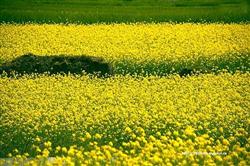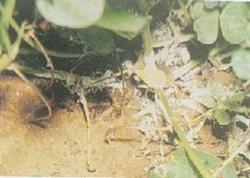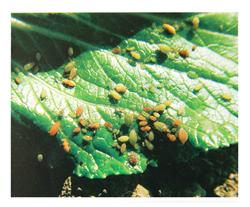Re-application of Boron in rape with High quality, High yield and stable yield

Rapeseed (Brassica napus L.) is a boron-demanding crop, especially high-yield and high-quality Brassica napus "double-low" hybrid rape is particularly sensitive to boron deficiency, slow root deficiency at seedling stage, dark green and wrinkled leaves, and growth hindrance; boron deficiency at bud stage, rhizome expansion, leaf color turning purple to blue-purple, abnormal flower bud development; boron deficiency at flowering stage, dwarfing plant, abnormal pollen development and few seeds. Practice has proved that the application of boron fertilizer in boron deficiency areas generally increases the yield of rapeseed by 1530%, and boron application can double the yield in seriously boron deficient plots. The application of boron fertilizer is an important technical measure for high and stable yield of rape. 1. The correct application of boron fertilizer can be used as base fertilizer, topdressing fertilizer and foliar fertilizer, but no matter which method is used, it must be applied according to the boron content in the soil and the growth of rape in the field. (1) the application of boron fertilizer at the bottom is suitable for the soil with moderate or severe boron deficiency, and the boron fertilizer at the bottom can ensure the continuous supply of boron and meet the boron demand of rape in each growth period in time. Before direct seeding or transplanting of rape, 1-1.5 kg borax per mu was fully mixed with farm fertilizer, chemical fertilizer or fine soil. When applying boron fertilizer, avoid direct contact with seeds or seedlings, so as not to burn or inhibit growth. (2) foliar spraying: foliar spraying boron fertilizer has the advantages of fertilizer saving and fast crop absorption, and can be effectively adjusted according to the boron requirements of rape at different growth stages. This method is suitable for rape with insufficient application of base fertilizer or soil with moderate or mild boron deficiency and potential boron deficiency. Foliar spraying should be sooner rather than later, and the best application period is the late seedling stage (before and after flower bud differentiation) and bolting stage (moss height 15cm 30cm), twice applied (about 15 days apart), spraying 0.2% borax solution 40kg / mu each time. The seedling bed or early flowering stage can be used as an auxiliary boron spraying measure according to the symptoms of boron deficiency, and the concentration is about 60 kg of borax solution with a concentration of 0.1-0.2%. The effect of spraying before sunny evening is the best, it is appropriate to spray rape leaves with fog droplets on both sides, and re-spray should be done in case of rain after spraying. 2. The problems that should be paid attention to in the use of boron fertilizer: 1. Strictly control the amount of boron: although boron is a necessary nutrient element for the growth of rape, it belongs to trace elements, and the application amount must be strictly controlled, even in the soil with serious boron deficiency. The amount of borax should not exceed 2 kg per mu, because excessive boron will cause crop boron poisoning. 2. Mastering the spraying time: boron is needed in the whole growth stage of rapeseed, and it is generally suitable for spraying at seedling stage and bud bolting stage. Boron spraying on rape leaves after flowering has no significant effect on increasing yield. Boron spraying at flowering stage is too late, and the effect is poor. However, boron spraying is basically ineffective at the stage of grain formation. 3, the use of high-quality boron fertilizer: at present, there are many kinds of boron fertilizer products sold in the agricultural market, some of which actually contain very low boron content and some contain almost no boron. The application of such boron fertilizer will undoubtedly lead to boron deficiency and yield reduction or no harvest of rape. Therefore, it is necessary to buy boron fertilizer at the regular agricultural sales outlets. 4. It is best to cooperate with other fertilizers: the yield-increasing effect of single application of boron fertilizer is not obvious, and the potential of increasing yield can be brought into full play when boron fertilizer is used in combination with organic fertilizer, nitrogen, phosphorus and potassium fertilizer.
- Prev

Comprehensive control measures of white silk disease of peanut
Peanut white silk disease is a kind of soil-borne fungal disease, which occurs at the stage of peanut pod expansion to maturity. After the damage to the root, pod and stem base of peanut, it first showed brown soft rot, white silky hyphae in the aboveground rhizome (so called white silk disease), and rape seed sclerotia, stem and leaf turned yellow, gradually withered, peanut pod.
- Next

Control techniques of rape aphids
Aphids, commonly known as greasy insects, are the main insect pests of rape in Linxiang area, which occur in the main producing areas of rape. When the drought is serious in winter and spring, the insect pests are more serious in the plots lacking irrigation conditions. The harm of aphids mainly occurs in the period from bolting to maturity of rape, and some yield losses will be caused if the control is not timely or improper. First, rapeseed aphid.
Related
- The first cup of black tea in spring, the flavor and history of tea gardens in Kenya, Africa
- The computer can not only choose potatoes, but also grow tea rice. AI will grow winter oolong tea champion.
- It is not only the inflated tea bitten by insects, but also engraved with the four seasons tea in Beipu.
- The Oriental Beauty Tea Festival in Zhuxian County takes the stage at the weekend to experience the plus-size feast of oil tea.
- & quot; Oriental Beauty Tea & Exploration of Emei in Hsinchu, the hometown of quot;
- The new variety of strawberry "Tainong 1" dessert is the first choice with mellow aroma. Crimson gorgeous
- History of Tea in Taiwan: from Wild Inner Mountain to Export Tea Garden
- Two types of Taiwan Oriental Beauty Black Tea won the British three-Star Award for Childhood Tea Xiang Zhang Jiaqi changed from pilot to champion tea maker.
- Banana species and varieties: the planting history of Taiwan Xianren banana and dwarf banana is long, is banana disease resistant?
- Coffee planting Technology: Qianjie Coffee from Seedling to harvesting

